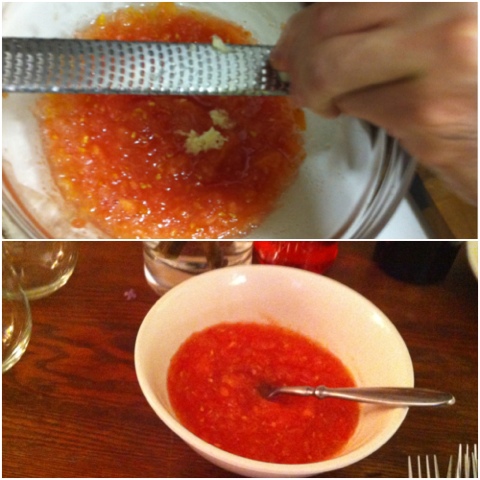Upon entering Ribiera Do Miño you are struck by two things...1.) This place is an old school, no frills kind of place and 2.) This is a hidden local gem free from tourists. The waiters are all men and are wearing their black and whites. They are fun and helpful but warning their english is NO BUENO, however you forgive them because of their hard working mentality. Luckily, I don't need a translator. ;)
Promptly upon sitting, we ordered our drink of choice which is Ribeiro Wine. Their Ribeiro is homemade, cold, sweet and refreshing. However, don't be fooled it packs a big punch and with signage warning "NO SINGING ALLOWED" on the walls, we had to limit ourselves to two bottles...you'll understand why later!
 |
| The Starters...Cockles, Padron Peppers, & Pulpo |
We started our feast with some appetizers of their most famous starters. 1st was Cockles in a Saffron Wine Sauce. These cockles were tender and flavorful but then again who doesn't like saffron. Saffron makes everything better. The highlight of this dish was the sauce that we all fought to soak up with our pieces of bread. 2nd was the Pimientos de Pardon. These little fried green devils are tricky. Some are sweet and some are spicy, we always play a little game of choosing peppers for each other and of course we always want the other to get a spicy one. Funny, Michael never thinks any of them are spicy. He thinks we Spaniards are weaklings in the spicy food department. 3rd and most famous was the Pulpo a la Gallega (Octopus Galician Style). This is a very simple dish to prepare. You boil the octupus, then season it with smoked sweet paprika, olive oil and salt. However, the way that they do it here and the quality of the ingredents that they use takes it to a whole other level...or even another universe!
 |
| THE MAIN EVENT - Warm Seafood Platter |
The main reason why we are here is THE WARM SEAFOOD PLATTER! This platter consists of gambas (regular shrimp), langostinos (prawns) and cigalas (langoustines or scampi). The 1st time, I brought Michael to this place he couldn't wrap his brain around how simply this platter is cooked. He thought there was some special sauce that they were cooked in or maybe some secret preparation but all that happens is that they are grilled with salt and olive oil. The reason for their delcious flavor is because of the sea region that they are brought from. Their flavor is incomparable, no other crustaceans come even close. I will let you in on a tiny secret, Michael and I always fight over the cigalas...but don't tell him, I always let him win.
 |
| Michael working his magic on the Caimada |
After eating our fill of shrimp and taking a little break, Michael ordered his favorite drink, a Caimada. A Caimada is a traditional punch that was created to ward off witches and bad spirits. It is made of Galician augardente, coffee, lemon peel, and sugar. It is brought to a boil and then lit on fire. As you can see from the photo it has a magical looking blue flame. Once it is brought to the table, you have to stir and ladle it while reciting the incantation against the evil beings. Just like the wine this "punch" will put hair on your chest. It is fun to drink and you have to hold yourself together or you will soon break the rule of NO SINGING.
 |
| Dessert Time |
My mother is not a fan of the Caimada however she does like to have her alcohol in her dessert. Filloas are crepes filled with pastry cream and then bathed in the augardente and then flambéed. The rest of us had a simple but oh so creamy flan.
 |
| Happiness |
As our evening was coming to an end, a few of us (especially Papa Carmena) were buzzing and on the verge of being drunk. Who could blame him with wine, punch, and the traditional end of the meal shot of orujo with herbs. This shot is for as they said "for digestive purposes." Yeah, right?! We all got home happy and content. Mission accomplished!




